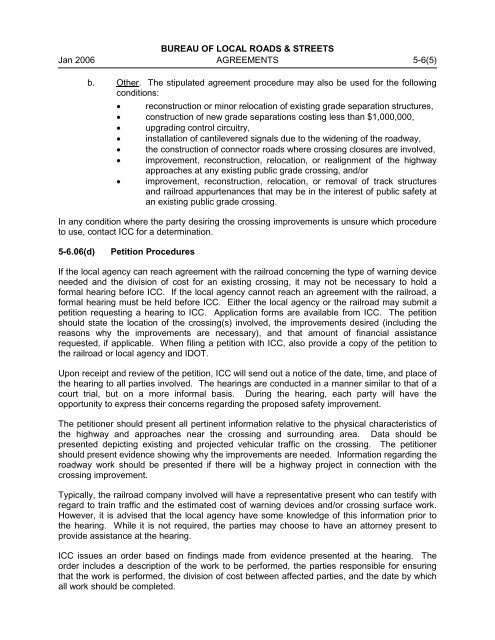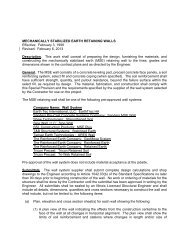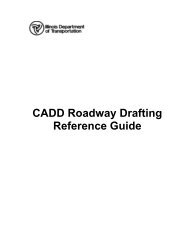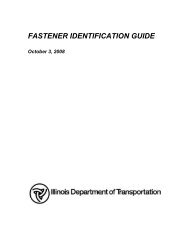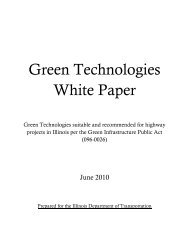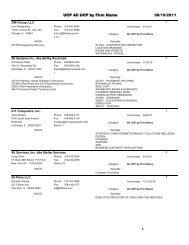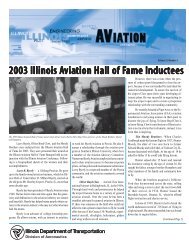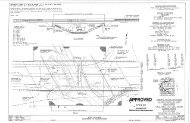Chapter Five AGREEMENTS - Illinois Department of Transportation
Chapter Five AGREEMENTS - Illinois Department of Transportation
Chapter Five AGREEMENTS - Illinois Department of Transportation
You also want an ePaper? Increase the reach of your titles
YUMPU automatically turns print PDFs into web optimized ePapers that Google loves.
BUREAU OF LOCAL ROADS & STREETS<br />
Jan 2006 <strong>AGREEMENTS</strong> 5-6(5)<br />
b. Other. The stipulated agreement procedure may also be used for the following<br />
conditions:<br />
• reconstruction or minor relocation <strong>of</strong> existing grade separation structures,<br />
• construction <strong>of</strong> new grade separations costing less than $1,000,000,<br />
• upgrading control circuitry,<br />
• installation <strong>of</strong> cantilevered signals due to the widening <strong>of</strong> the roadway,<br />
• the construction <strong>of</strong> connector roads where crossing closures are involved,<br />
• improvement, reconstruction, relocation, or realignment <strong>of</strong> the highway<br />
approaches at any existing public grade crossing, and/or<br />
• improvement, reconstruction, relocation, or removal <strong>of</strong> track structures<br />
and railroad appurtenances that may be in the interest <strong>of</strong> public safety at<br />
an existing public grade crossing.<br />
In any condition where the party desiring the crossing improvements is unsure which procedure<br />
to use, contact ICC for a determination.<br />
5-6.06(d) Petition Procedures<br />
If the local agency can reach agreement with the railroad concerning the type <strong>of</strong> warning device<br />
needed and the division <strong>of</strong> cost for an existing crossing, it may not be necessary to hold a<br />
formal hearing before ICC. If the local agency cannot reach an agreement with the railroad, a<br />
formal hearing must be held before ICC. Either the local agency or the railroad may submit a<br />
petition requesting a hearing to ICC. Application forms are available from ICC. The petition<br />
should state the location <strong>of</strong> the crossing(s) involved, the improvements desired (including the<br />
reasons why the improvements are necessary), and that amount <strong>of</strong> financial assistance<br />
requested, if applicable. When filing a petition with ICC, also provide a copy <strong>of</strong> the petition to<br />
the railroad or local agency and IDOT.<br />
Upon receipt and review <strong>of</strong> the petition, ICC will send out a notice <strong>of</strong> the date, time, and place <strong>of</strong><br />
the hearing to all parties involved. The hearings are conducted in a manner similar to that <strong>of</strong> a<br />
court trial, but on a more informal basis. During the hearing, each party will have the<br />
opportunity to express their concerns regarding the proposed safety improvement.<br />
The petitioner should present all pertinent information relative to the physical characteristics <strong>of</strong><br />
the highway and approaches near the crossing and surrounding area. Data should be<br />
presented depicting existing and projected vehicular traffic on the crossing. The petitioner<br />
should present evidence showing why the improvements are needed. Information regarding the<br />
roadway work should be presented if there will be a highway project in connection with the<br />
crossing improvement.<br />
Typically, the railroad company involved will have a representative present who can testify with<br />
regard to train traffic and the estimated cost <strong>of</strong> warning devices and/or crossing surface work.<br />
However, it is advised that the local agency have some knowledge <strong>of</strong> this information prior to<br />
the hearing. While it is not required, the parties may choose to have an attorney present to<br />
provide assistance at the hearing.<br />
ICC issues an order based on findings made from evidence presented at the hearing. The<br />
order includes a description <strong>of</strong> the work to be performed, the parties responsible for ensuring<br />
that the work is performed, the division <strong>of</strong> cost between affected parties, and the date by which<br />
all work should be completed.


